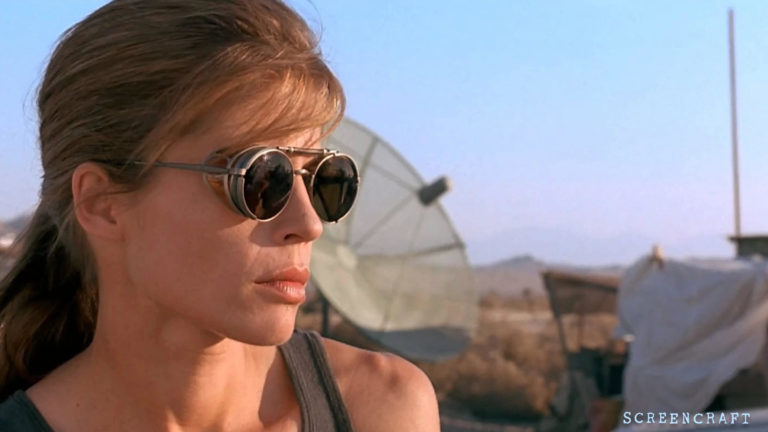Defining Character Through Action: 'Terminator 2: Judgement Day'

We're back with another installment of "Defining Character Through Action," where we break down iconic films that use the things characters do to tell us who they are.
This time around, we're looking at one of the most iconic characters in action movie history — Sarah Connor from Terminator 2: Judgement Day.
We'll explore some of Sarah's character-defining actions and reactions, revealing that they often speak louder than her dialogue ever does.
Here we go!
Note: The script for Terminator 2: Judgement Day available online has elements not present within the film's final cut. It also uses camera directions that spec screenplays should not have. Beyond the character introduction, we will be taking examples from the final cut of the film.
Sarah Connor: Character Overview
The 1991 blockbuster sequel to the sleeper 1984 The Terminator tells the story of a cyborg, identical to the one who failed to kill Sarah Connor in the first film, who must now protect her ten-year-old son, John Connor, from a more advanced and powerful Terminator.
The screenplay first introduces Sarah anonymously — we can't see her face.
A WOMAN in a tank top and hospital pants is hanginig from the top leg of a vertical bedframe. Her body is straight and taut. Knees bent so the feet clear the ground. The arms are lean and muscular. The inmate, face hidden, pulls up, dips, pulls up. Like a machine. No change in rhythm.
We get some physical keywords that showcase who Sarah Connor has become.
- Lean
- Muscular
- Like a machine
From this first description, we know that she's not the young and naive girl she was in the first film. She has been conditioned. And she continues to condition herself. The duality of describing her actions as being like that of a machine is fascinating. We'll get to that in a bit.
Here is her further introduction and description.
SARAH CONNOR is not the same woman as we remember from last time. Her eyes peer out through a wild tangle of hair like those of a cornered animal. Defiant and intense, but skittering around looking for escape at the same time. Fight or flight. Down one cheek is a long scar, from just below the eye to her upper lip. Her VOICE is a low and chilling monotone.
With this extended description, we get even more keywords that summarize here state through visuals.
- Cornered animal
- Defiant
- Intense
- Fight or flight
- Long scar
From these descriptions, we understand that Sarah is a survivor. She's conditioned herself to be one. And she's capable of anything. It's a fantastic setup for the moments to come.
Character-Defining Action #1: Constantly Training
Despite being detained, we watch as Sarah constantly continues to train. She's keeping herself in tip-top shape because she knows that Judgement Day is coming. And she knows that a Terminator could return at any time. She even opts to sleep on the hard floor in a makeshift tent in the script and film.
She doesn't want to grow soft. She wants to stay hard and prepared for anything that comes her way.
This is a vast difference between where she was in the first film. And it's only the beginning of what differences we'll see in her since we last saw her.
Character-Defining Action #2: Calculating and Smart
Later on, Sarah is shown an early video of her declaring what she knows about the future. In the video, she's on edge and loses her mind — having to be subdued. Then we cut back to Sarah, watching the video, who says:
I feel much better now. Clearer.
She's calm and soft-spoken. And she's clearly putting on a show as she requests to be able to see her son, John Connor. The lead psychiatrist denies her request, which sets Sarah off in a rage as she attacks him.
This showcases to us that she's calculating and calm. She's not just some crazy mental patient overwhelmed by the truth that she knows. Sarah is fully aware. But the rage that she showcases also tells us that she's desperate and trapped.
Shortly after, Sarah is medicated and is strapped down to her cell's bed by an orderly that proceeds to molest her with his tongue. She doesn't react. She's frozen, making us think that she's been overly medicated.
When the orderly leaves, Sarah is alert. She spits out a paperclip that she stole during her altercation with the psychiatrist. It was all a ruse, which helps understand how smart and calculating she really is.
Character-Defining Action #3: Ruthless and Adaptive
Sarah makes a daring escape. During her actions, we quickly see how ruthless and adaptive she has become — a clear result of her training, which we learn about later in the story.
- She brutally attacks the orderly that molested her.
- She quickly takes out an orderly.
- She takes the lead psychiatrist captive in equally brutal fashion by sinking a syringe filled with chemicals into his neck.
- She talks her way through locked gate doors.
Her actions are ruthless. In her eyes, all of these people are going to die anyway. Her mission, to get to her son to protect him from any threats, is all that matters. She doesn't hesitate to break noses, break arms, and threaten the life of her psychiatrist.
And she is impressively adaptive during her escape.
These actions show us how she will be well-equipped to deal with the threat we know is coming.
However, once her escape attempt goes south and she's waiting for an elevator to return, we learn something new from her. Something unexpected.
Character-Defining Action #4: Trauma and Fear
Despite her survival skills, training, smarts, calculative mind, ruthlessness, and adaptivity, she's terrified and instantly traumatized when she lays eyes upon the very Terminator model that stalked her in the first film.
We see her instantly revert to that scared young woman we met in the first film — just at the sight of the Terminator. Even when she sees her son and is told that the T-800 is there to help, she's wary.
And this continues throughout the second act. In a deleted scene within the script and Director's Cut, she even attempts to destroy the T-800's chip during repairs. John stops her.
Character-Defining Action #5: Protecting the Savior
After a chase sequence during which the new Terminator, the T-1000, nearly kills them all with a barrage of bullets and metal stabbing weapons, the first thing that Sarah does is embrace her son John. At first, John thinks that she's hugging him. But he soon notices that she's checking him for wounds.
Her actions are less about motherly instincts and love for her son — and more about protecting the savior of the human race. This action shows us the mental and emotional damage that has been done through her journey. It also shows us where her intentions lay.
Sarah doesn't care about herself. She doesn't care about anyone else beyond her son. She knows that he's the savior of the human race. And it is her mission to prepare and protect him.
Character-Defining Action #6: Sarah Becomes a Terminator
Once they find solitude with a group of Sarah's old friends, Sarah later realizes that further action must be taken. The T-800 tells her the history of Skynet. She learns that Miles Dyson is the man that created Skynet. She then realizes that if she can terminate him, there won't be any Skynet to take over the world.
She leaves on her own, fully armed and ready to kill Miles Dyson. But when the time comes for her to pull the trigger as she is face-to-face with him, she can't.
We learn that her ruthlessness only goes so far.
From that point on, Sarah's arc begins to turn.
Read ScreenCraft's Exploration of Character Inner and Outer Arcs!
Screenwriting Lesson Learned?
Don't rely on writing detailed scene descriptions and expositional dialogue to showcase characterization in your screenplays. Those elements are a waste of prime screenplay real estate. And they also slow the pacing of the script down.
Instead, throw your characters into the fire of the conflict and let their actions and reactions define them.
---
Read the other installments of our "Defining Character Through Action" series!
Ken Miyamoto has worked in the film industry for nearly two decades, most notably as a studio liaison for Sony Studios and then as a script reader and story analyst for Sony Pictures.
He has many studio meetings under his belt as a produced screenwriter, meeting with the likes of Sony, Dreamworks, Universal, Disney, Warner Brothers, as well as many production and management companies. He has had a previous development deal with Lionsgate, as well as multiple writing assignments, including the produced miniseries Blackout, starring Anne Heche, Sean Patrick Flanery, Billy Zane, James Brolin, Haylie Duff, Brian Bloom, Eric La Salle, and Bruce Boxleitner, and the feature thriller Hunter’s Creed starring Duane “Dog the Bounty Hunter” Chapman, Wesley Truman Daniel, Mickey O’Sullivan, John Victor Allen, and James Errico. Follow Ken on Twitter @KenMovies
For all the latest ScreenCraft news and updates, follow us on Twitter, Facebook, and Instagram.
Tags
Get Our Screenwriting Newsletter!
Get weekly writing inspiration delivered to your inbox - including industry news, popular articles, and more!



























